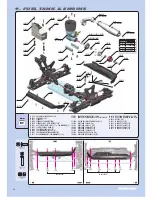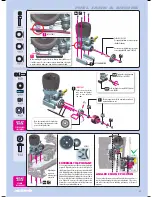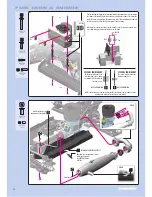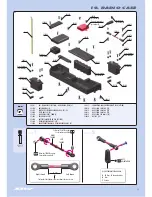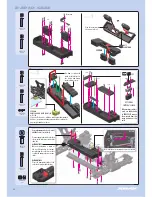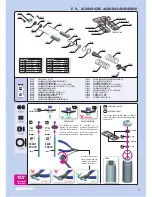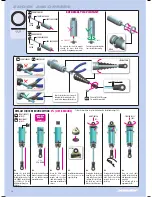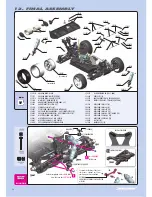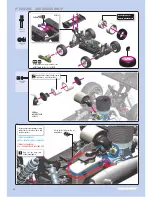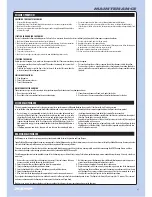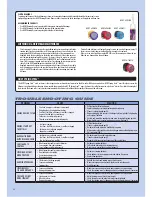
41
• Never modify the engine or muffler.
• Confirm the position of needle and idling before running. Be sure to run a new engine smoothly.
• Make sure the air filter is clean and oiled.
• Never run your engine without an air filter. Your engine can be seriously damaged if dirt and debris
get inside the engine.
• For proper engine break-in, please refer to the manual that came with the engine.
• The engine may not start or run properly if the air filter is dirty, or choked with sand and dust.
• If the fuel pipe is choked or deteriorates, the engine may not start, and there is danger that fuel will
leak out.
1. Make sure the transmitter and receiver batteries are fully charged.
2. Make sure that your transmitter and receiver are both on the same frequency. If you have a transmitter
with multiple model memory, make sure you have selected the proper profile for your car.
3. Put the car on the starter box and keep the tires from touching the ground.
4. Turn on the transmitter.
5. Turn on the receiver in the car.
6. Make sure the steering servo and engine servos work normally and adjust them correctly.
7. Put fuel in the fuel tank, and close the cap securely.
8. Apply the glow igniter to the engine glowplug.
9. Push the model car onto the starter box to start the engine. (If the engine is new, follow the instruction
manual and be sure to break in the new engine properly).
10. When the engine has started, remove the glow igniter.
11. Follow your engine break-in procedure and tune the engine as appropriate.
STARTING AND RUNNING THE ENGINE
Be sure to observe the following starting process. Failure to do so may cause the model car to start suddenly, which may lead to damage or unexpected accidents.
STOppING THE ENGINE
Before you stop the engine, try to make sure the engine is at idle first. There are several ways to stop the engine:
• Use a rag to cover the exhaust tip. Be careful! The exhaust is extremely hot so use a thick
rag and gloves.
• Pinch the fuel tubing to stop the flow of fuel to the carb. Be careful, this can make the
motor run lean which can damage the motor.
• Put your hand over the air filter, or squeeze the air filter element to block the airflow.
• Press an object (such as a screwdriver handle or shoe) against the rotating flywheel to
stop its rotation. Be very careful, and do not stick your hand or fingers near the rotating
flywheel.
FINISHING OpERATIONS
1. Stop the engine.
2. Turn off the receiver in the car
3. Turn off the transmitter.
MAINTENANcE AFTER RUNNING
Take proper care of your car after running to keep it performing well, and take notice of any damage and wear.
1. Do not leave fuel in the tank.
2. Go outside to drain any residual fuel from the exhaust pipe.
3. Clean the car and remove all sand, mud, and other debris.
4. Use after-run oil in your engine after you have finished running for the day.
• For club racing, it is recommended to check the shocks for air inside before each race
and only re-fill and bleed them if necessary. Before each race day, make sure you take
the spring off of each shock, hold it up to your ear, and quickly compress the shock rod
fully into the body while listening for any air making a “whistling” or “squishy” sound as
it passes through the piston holes. If you hear any air, refill and bleed your shocks. For
high-competition racing, it is recommended that the shocks be re-filled and bled before a
large event.
• If building or pairing new shocks, always make sure they are the same length using a
shock length measuring tool and adjust the lower ball joints as needed.
• If installing new rubber bladders, carefully trim the thin excess rubber from the edges of
their lips. Curved body scissors work the best.
• Regularly inspect the amount of dirt on the felt protector in the shocks (if present) and
regularly replace with a new one.
• During regular shock operation, oil naturally gets on the shock shaft and drop-by-drop
slightly gets out of the shock body. Shocks should be inspected regularly after each race,
and oil replaced as required.
1. Remove the seals on both sides of the bearing (if present). If the seals bend a little and
you can see a kink, carefully flatten the kink out by hand.
2. Spray the seals with motor cleaner and blow dry with compressed air.
3. Spray the bearing on both sides with motor cleaner.
4. Spin the bearing while it is still wet to dislodge any particles with the cleaner.
5. Spray the bearing on both sides again.
6. Blow both sides of the bearing dry with compressed air to make sure particles come out.
7. Hold the inner part of the bearing with my left thumb/forefinger and spin it to make sure
it spins free without any abnormal vibrations or sounds.
8. Place one drop of bearing oil into each side of the bearing.
9. Replace both seals at the same time by lining them up on each side of the bearing and
lightly pressing them in all the way around the bearings circumference with your thumb
and forefinger. Do not press too hard or use any type of tool, such as a wrench tip, to push
the blue seals in as they will push in too far, bend and cause drag.
If you spin test the bearing after you have re-oiled and sealed it, it will not spin freely for an extended period of time. The lightest of oils may allow it to spin for 1-2 seconds. This is normal
and once you have mounted the bearings in the car again, the drive train will spin freely.
Make sure you use a motor cleaner that does not leave a residue after it dries as this may cause drag and wear in the bearings.
ENGINE OpERATION
pREpARING TO OpERATE THE ENGINE
SHOck MAINTENANcE
The most important maintenance task for keeping consistent shock performance is refilling and bleeding them correctly. If built correctly, it will not be necessary
to re-build them often. Replacing warped/hard rubber bladders and o-rings, scarred piston rods, or shaved/split/loose composite upper and lower ball joints are also important.
BEARING MAINTENANcE
Ball-bearings in an off-road car or truggy must be properly maintained for smooth operation and long lifespan.
Typically, the ball-bearings included in new cars are greased for highest lifespan and as such the drivetrain may not seem to be as free as with lightly-oiled ball-bearings. However, when the
car is run the ball-bearings will become more free and the drivetrain will become very efficient.
There are several types of bearings discussed here: bearings which already come greased from the factory, bearings which must be lubricated using the HUDY Bearing Grease, and then
there are also bearings in the steering system which need to be lubricated with HUDY Bearing Oil.
The following procedures are recommended to clean all of the bearings in your off-road car or truggy. For high-competition racing, we recommended doing this every 3-4 weeks, or before a
major race.
MAINTENANCE
Summary of Contents for XB9
Page 1: ......


